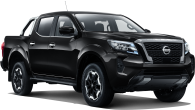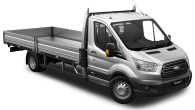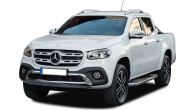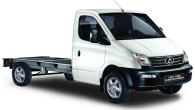You want a Ford Ranger Raptor, but you can’t quite justify the extra expense.
You want a Ford Ranger Raptor, but you need more towing capacity.
You want a Ford Ranger Raptor, but you need better payload capability.
You need to take a look at the 2021 Ford Ranger FX4 Max, which takes some of the stuff we love about the Raptor, but has better towing, load and pricing.
And in this test, we’re checking out how it handles towing.
Ford Ranger 2021: FX4 2.0 (4X4)
| Engine Type | Diesel Twin Turbo 4, 2.0L |
|---|---|
| Fuel Type | Diesel |
| Fuel Efficiency | 8.0L/100km (combined) |
| Seating | 5 |
| Price From | $43,010 - $50,050 |
| Safety Rating |
|
Does it represent good value for the price? What features does it come with?
With a price tag of $65,940 (MSRP - plus on-road costs) the Ford Ranger FX4 Max is at the upper end of its segment of dual cab utes.

But that also represents a healthy $11,750 discount over a Raptor - despite getting the same engine and transmission, a number of carryover components and a very competent array of capability.
The standard equipment includes Fox Shocks dampers front and rear, revised steering components, 17-inch alloy wheels with 33-inch BF Goodrich KO2 Baja Champion all-terrain tyres (265/70/17), off road side steps, a different grille, a bank of auxiliary switches teamed to an uprated alternator, embroidered model-specific FX4 Max seats, and an optional rowdy looking sticker pack.

That’s in addition to the standard stuff you’d find on the XLT grade this variant is based upon, including a sports bar (finished in black), LED headlights with LED daytime running lights, halogen fog lights, front and rear mud flaps, a tow bar, front and rear parking sensors, an 8.0-inch touchscreen media system with Apple CarPlay and Android Auto, sat nav, reversing camera, Bluetooth phone and audio streaming, keyless entry and push-button start, auto high beam lights and an extensive array of safety features - more on that below.
Want to know more about Ford Ranger colours? Only Arctic White is a no-cost paint option for FX4 Max. The optional finishes include Conquer Grey (as seen here), Aluminium silver, Alabaster White, Lightning Blue, Meteor Grey and Shadow Black, and those all cost you $650.
Is there anything interesting about its design?
The Ranger FX4 Max isn’t a standard ute to look at - but nor is it as outlandish or broad-shouldered as the Raptor.
It has the standard Ranger body dimensions, meaning it’s 5446mm long on a 3220mm wheelbase, 1977mm wide (with mirrors folded), and 1852mm tall. But because it has the Fox Shocks and taller 33” tyres, the body is sitting a little higher than an XLT (1848mm).

In fact, it has a load in height of 871mm, which is 31mm taller than a Wildtrak or XLT, and means you will need to heave heavier items into the tray with a bit more oomph.
That doesn’t necessarily translate to a better towing experience, either. A lower centre of gravity as well as heavy mass of the tow vehicle typically translates to better handling and ease of towing, but thankfully, it’s not as though the FX4 Max has a lift kit fitted.
Instead, the 2.0-inch monotube Fox Shocks shock absorbers are fitted front and rear. The rear suspension maintains a leaf spring layout, but the rear shocks have a remote reservoir to apparently allow for optimal comfort and control. The front suspension has been tweaked for better control, too, with the coil spring setup including new lock-stop profile steering knuckles, new jounce bumpers and a 29mm stabiliser bar.

And if you’re wondering about weight over those axles, the FX4 Max has a kerb mass of 2219kg, with a payload capacity of 981kg. The gross vehicle mass (GVM/GVW) is 3200kg, while the gross combination mass (GCM) is 6000kg - meaning you cannot be at payload capacity and towing a maximum load behind.
The towing capacity is 750kg unbraked and 3500kg braked - a full 1000kg advantage over the Raptor. And the FX4 Max’s payload rating is some 228kg higher than the Raptor (758kg).
How practical is the space inside?
The interior of the FX4 Max will be largely familiar to anyone who has sat in or driven or owned a PX series Ranger post-facelift. The cabin is well laid out for the most part, and roomy and practical as well.
The storage includes bottle holders in all four doors, cup holders between the front seats, a flip down rear cup holder / armrest, map pockets in the back, a flip-up seat base in the rear for additional stowage, a decent glovebox and a few other bins and niches for loose items.

The seats are comfortable and offer good adjustment for front seat occupants, both are manually adjustable. There is no seat heating or steering wheel heating.
The media system is mostly good, with the requisite smartphone mirroring options, built-in sat nav and DAB digital radio. However, no matter how much time I spend in Ranger models, I do hope the next version has better HVAC controls, as you need to interact both through buttons on the centre console and through the media screen for fan adjustment.

Rear adult occupants will have enough room to be comfortable - I’m 182cm or 6’0” tall, and can comfortably sit behind my own driving position without too much limitation on knee room and toe room. Head room and should space is good, and you can fit three across if you need to. If you have children, there are two ISOFIX and two top-tether attachments.
What are the key stats for the engine and transmission?
The FX4 Max is only sold with the brand’s 2.0-litre four-cylinder Bi-turbo diesel engine.
The outputs bely the capacity of the engine, with a hefty 157kW of power (at 3750rpm) and 500Nm of torque (from 1750-2000rpm). Those are class-equalling four-cylinder engine outputs, and best in the market for an engine of this capacity.
This engine is only available teamed to a 10-speed automatic transmission, and there are no paddle shifters - but there is a manual mode toggle switch on the selector.
The Ranger comes with selectable four-wheel drive (4WD or 4x4), and an electronic locking rear diff is standard too.
The Ranger FX4 Max has a kerb weight of 2219kg, which is heavy. Towing capacity is 750kg for unbraked loads and 3500kg for braked trailers - the best you can get in this size segment.
The gross vehicle mass (GVM) is 3200kg, and the gross combination mass (GCM) is 6000kg, so keep in mind you cannot legally run the vehicle at payload and tow the maximum braked trailer. You’d be looking at closer to a 2800kg trailer maxed out.
How much fuel does it consume?
Official combined cycle fuel consumption is 8.0 litres per 100 kilometres - there’s only one figure, as there’s only one engine/transmission combo offered for this spec.
During our testing loop with the 2.3-tonne chipper in tow, we saw a real-world at the pump return of 13.0L/100km, which is pretty good.
The Ford Ranger has an 80 litre fuel tank capacity. There is no long range fuel tank option but it does have fuel saving start-stop technology.
It runs at Euro 5 emissions levels, with a diesel particulate filter (DPF) fitted. The stated emissions are 210g/km CO2, which is low for the class.
Warranty & Safety Rating
What safety equipment is fitted? What safety rating?
All Ford Ranger models come with a good array of safety equipment - even though its five-star ANCAP crash test safety rating applicable to the current version dates back to 2015.

Standard equipment on the FX4 Max includes auto emergency braking (AEB) with pedestrian detection, lane keeping assistance, auto high-beam lights, front and rear parking sensors, a reversing camera, roll-over mitigation, load adaptive stability and traction control with trailer sway control, tyre pressure monitoring, traffic sign recognition, driver fatigue monitoring and six airbags (dual front, front side and full-length curtain).
There is an optional Premium Pack with adaptive cruise control and semi-autonomous park assist, too, which costs $800.
What does it cost to own? What warranty is offered?
Buy a Ford Ranger and you get a five-year/unlimited kilometre warranty plan included.
That also covers five years of roadside assistance, and there’s a lifetime capped price servicing plan. The first four services are cheap, at $299 per visit.
Service intervals are every 12 months/15,000km.
Read our Ford Ranger problems page for more info on concerns, issues, recalls, problems or common complaints.
What's it like as a daily driver?
I’ve always thought of the Ranger - in normal leaf spring guise - as one of the best utes in the segment to drive, but with Fox Shocks the case is pushed even further toward GOAT status.
The ride is supple and composed, with excellent comfort over lumps and bumps. You can still tell it’s a ladder-frame, leaf-sprung ute, but those big BF Goodrich tyres help it feel assured and secure.
The steering is excellent - fingertip light and easy to judge, despite lacking some feel to the driver’s hands. It’s so easy to park this ute, it seems to almost defy physics.
The engine and transmission are mostly really good in daily driving, too. The downsized bi-turbo engine seemed to have a bit more low-speed lag in this version of the Ranger than in others I’ve driven, and that could come down to the tyres having better grip on the surface below and the engine needing a bit more throttle to take off from a standstill.
Once moving though, the powertrain offers excellent grunt. It’s smooth, refined and the 10-speed auto - while at times fussy and busy between the ratios - always finds the right cog to allow you access to the torque on offer.
My biggest annoyance isn’t actually driving the Ranger FX4 Max - it’s getting in and out of it. Those side steps jut out way too far, and I constantly found myself stumbling to get in, or worse, bashing my shins while reaching into the cabin. Annoying!
Those were the drive impressions for unladen, unhitched driving. What about how it tows?
What’s it like for tradie use?
We hired a 2.3-tonne Vermeer chipper from Kennards Penrith for the purposes of this test, to see what a ute like this will feasibly be up against when it comes to hauling.
Firstly, the hitch is simple - there’s a really good quality reversing camera and rear sensors, but the camera itself has a zoom button to allow you to perfectly line up the towball where you need it. This takes a lot of guesswork out of the equation, and is a standard feature on all Ford Ranger models.

Once hooked up, we towed across a series of different scenarios, including back street industrial areas, open road urban, highway, freeway and even twisty mountain road testing, and there was very little to find issue with.
The rear suspension offered a level of controlled confidence rarely found in this type of vehicle, and I could barely feel the weight behind the vehicle because it was such a confident tow truck. The balance of the suspension was excellent - it never felt like the front end was out of whack with what was going on at the back, and certainly offers a commendable option to those who want a tow vehicle for work (trailer, chipper) and play (caravan, camper trailer).
The visibility was good - those Ranger mirrors are large as standard, thankfully - and it was really quite easy to judge the size of the vehicle and its towed load from the driver’s seat.

The engine and transmission were up for the task, happily sitting at freeway speeds and also easily adapting to urban driving conditions - despite some low speed confusion with 10 gears to play with. I found using the manual mode trigger at lower speeds to be a good way to get around any potential jostling between the lower gears. I found that with 2300kg behind, the transmission was mostly fine at higher speeds - but if you're pushing up to (or beyond) three tonnes, you might need to rely on manual mode a bit more readily.
Of course, our vehicle had an electronic brake controller to cope with that much weight in tow, and the braking performance was exceptional - even with drums at the rear axle (discs up front).
After more than 150km of towing in mixed driving, the Ranger FX4 Max showed itself to be a confidence-inspiring dual cab ute, one that I would highly recommend for those in the market for such a truck.
Verdict
You don’t need a Raptor as much as you may want one. And if you’re a tradie, the Ford Ranger FX4 Max gives you a lot of the desirable elements of that truck, but with a more determined capability and real-world usability.
Thanks to our mates at Kennards Hire Penrith for helping with this test.
Pricing Guides


.jpg)
.jpg)
.jpg)
.jpg)




















.jpg)
.jpg)



